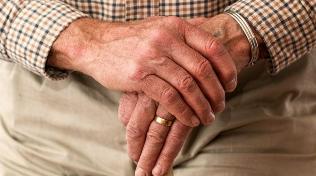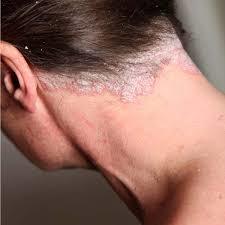The characteristic sign of psoriasis is predominant, the location of papules symmetrically on the skin-extensor surfaces of the hands and feet, as well as the scalp.

Despite the fact that a leading role in the development of psoriasis is played by the presence of a genetic predisposition (psoriasis applies to diseases transmitted by inheritance), the pulse at the onset of the disease can serve a multitude of exo-and endogenous factors (development of psoriasis on the nervous system, on a background of endocrine disorders, after infectious diseases, etc).
The etiological factors of development of the disease
The disease has no predisposing sexual, therefore, the frequency of occurrence of a psoriasis in men and women is not different. 12 percent of patients of the disease for the first time, develops up to ten years. In twenty years, the psoriasis develops in the forty-six percent of the patients, and at the age of thirty to sixty percent.
In the development of psoriasis highlight the two age points:
- twenty-seven and fifty-four years for men;
- fifteen and fifty-four years for women.
The causes of psoriasis in adults
The exact cause of psoriasis is unknown. The main role in the pathogenesis of the disease belongs to a genetic predisposition. Also, an important role plays the aspect of immunological instability, lipid disorders, and the presence in the patient foci of chronic infection.
In favor of the theory of genetic (hereditary causes of psoriasis) is evidenced by the fact that the disease is still not only the patient, but also of his close relatives.
Reveal a predisposition to psoriasis, you can during the realization of the classical genome analysis. In these patients can be more than ten loci in chromosomes, which are responsible for a genetic predisposition to the disease (PSORS-1 to 9, as well as HLA – B27, 17, etc).
The main gene responsible to maximize expressed by innate predispositions in the development of the disease, consider PSORS1.
Also, in the pathogenesis of psoriasis play an important role genetically resulting from the violation of the metabolism of carbohydrates and lipids. Most of patients with psoriasis reveal heavy, hyperlipidemia, and the metabolic syndrome. In this regard, the patients with psoriasis is higher risk of developing a heavy early atherosclerotic vascular lesions and cardiovascular diseases.
In addition to hyperlipidemia, emphasized the disorders of metabolism LCD (fatty acids), the increased production of free radicals of compounds involved in the cornification of the epidermis, etc
In the study of psoriatic plaques, revealed a high content of oxidized low-density lipoprotein.
The main markers for assessing the proliferation of keratinocytes in the hearth of psoriasis, are the protein Ki67, and keratin-six, sixteen and seventeen. These markers are responsible expressed by the process of hyperplasia, disorders of differentiation of cells and development of inflammatory reactions in the dermis.
Thanks to this, even when the occurrence of the phase of clinical recovery in psoriasis (disappearance of the inflammation of the skin), can persist in an inflammatory process in the vessels of the dermis.
Also, in the development of inflammation in the focus of the psoriasis which play a role in activated T-lymphocytic cells, the mediators of the inflammatory response, the inflammation in the microcirculation of the current. During the study of the microflora of the skin in patients with psoriasis to identify the streptococci, encourage the development and worsening of the tear psoriasis.
Immunologic basis of the pathogenesis of development of psoriasis is the progression of activated immune cells AvecD4+ T-lymphocyte cells and cytokines with anti-inflammatory properties. In favour of this theory shows that the monoclonal antibody in the treatment of psoriasis, operating against activated AvecD4+ T-lymphocyte cells have a therapeutic effect. Also, an effective tool for psoriasis are preparations for the inhibition of the production of tumor necrosis factors.
Is contagious if the psoriasis of the skin to the other
No. Psoriasis is a genetic disease.
Is psoriasis from person to person
No. Infected psoriasis of the other man is impossible. Although a streptococcal infection may serve as a factor causing, in humans without a genetic predisposition to the onset of the disease, the psoriasis will not arise.
Is psoriasis sexually
No. Psoriasis is not contagious and is neither droplets nor contact, nor transmitted, nor any other way.
Is psoriasis by inheritance
For the development of the psoriasis is necessary genetic (hereditary) predisposition. Therefore, the disease is common in relatives. In the presence of psoriasis among the parents, there is the risk of psoriasis and the child.
However, some authors suggest separately psoriasis of the second type. It is assumed that this option psoriasis, the development, in patients after forty years, and that primarily affects the joints and nails of the plate, it is not linked to heredity.
Is it possible to die of psoriasis
No. Psoriasis is not life-threatening disease. Forecast for the life of these patients is favorable.
However, psoriasis is very difficult to complete life of a patient, by making him the mass of the discomfort, and the reduction of its social activity.
Also, it should be noted that pustular form of psoriasis can be extremely difficult, leading to flushing and suppuration pustules, with the continuation of the otpadeniem of the skin-type "lakes". In this case, it is possible to develop dermatitis, bacterial complications, secondary to joint damage, etc
The triggering factors of development of psoriasis
Causing factors that contribute to the occurrence of flare-ups of psoriasis, are the following:
- the injuries of the skin;
- endocrine disorders;
- of pregnancy.
- the occurrence of metabolic disorders;
- the supplementation with beta-blockers, antiretrovirals cp-v, etc;
- the presence of foci of chronic infections (especially streptococcal infections);
- the abuse of alcohol;
- smoking;
- the excess of insolation;
- spicy, sweet, fatty, etc food;
- infectious diseases;
- the exacerbation of allergic diseases;
- the stress, the emotional overload (psoriasis on the nervous system worsens, most often).
The classification of psoriasis
According to the varieties secrete the form of psoriasis:
- vulgaris (common form of psoriasis);
- wet;
- inveterate palmo-plantar;
- warty;
- follicular;
- nails;
- pustular;
The course of the disease can bring gradual, locked-in nature.
The prevalence of lesions secrete limited to, common and widespread.
Can also mark the seasonality of exacerbations: winter, summer and uncertain (not related to the season) of the worsening of psoriasis.
Pictures, symptoms and treatment of psoriasis in adults

For psoriasis characterized by the appearance of pinkish-red or bright red papules, covered with silver, flaky skin whitish, soft consistency. Itching of the skin may be absent. Many patients indicate the occurrence of the particular sensation of tightness of the skin.
Itching intense, characteristic, usually for psoriatic is a skin lesion of the scalp and the perineum.
The onset of pain in the joints is celebrated during the development of psoriatic arthritis.
The most characteristic feature of the manifestation of psoriasis is a triad of specific symptoms :
- the emergence of the phenomenon of spot of stearin (gain of peeling at diagnosis of psoriatic arthritis papules, as a result of what it is like stearic acid blob);
- the film appearance of terminal (appearance of a fine transparent film, remaining after poskablivanii will be separated all peeling);
- the onset of clot dew, and the aspect of the bleeding point on the place of discharge terminals of movies.
Psoriatic papules may bring isolated or merge. Can vary in size from the small - before covering a large surface of the skin. The most common, the location of the papules are the elbows, the knees, the head (its fibrous part) and the lower back.
In rare cases, the plates may hit the mucous membrane of the lips and the oral cavity.
In children, in elderly patients and people with diabetes can develop folded form of the disease. In this case, affects the skin behind the ears, armpits, perineum, gluteal folds around the navel and below the breasts.
In patients with psoriasis may be absent of flaking. The surface of the psoriatic foci can be absolutely smooth, red. In some cases, may be the emergence of the maceration of the folds.
In some patients, the only manifestation of the disease may be plaques on the skin and mucous membranes of the genital area.
Usually, the skin lesions psoriatic bear the reflection of nature, but some patients may experience unilateral eruption. You can also receive braces psoriatic burners (annular, arched, geographic, etc).
In patients with sustainable flows out of the disease, long-plate existing on the skin of the lumbar region and buttocks can be accompanied by the appearance on them warty of growths.
In addition, the causes of the appearance of warty forms of psoriasis can be used:
- purulent infection of the skin;
- bad a external treatment (usually self-medication);
- the excess body weight.
When the warty forms of the disease, the scales are beginning to elbows, forming on the surface of platelets golden yellow.
Some patients may occur in isolation from flowing palmo-plantar psoriasis. In this case, the patient worried about the painful fissuring, pustules, papules, erythematous-squamous blister on the palms and feet.
Frequent manifestation of psoriasis is the defeat of the nail plate. In most cases, highlights the emergence of hollow points on the surface of the nail (dystrophy). They may also appear in the deformation of the nail, longitudinal and transverse furrows, thickening of the nail plate, its release and the color change, bleeding under the nail plate.
When erythrodermic psoriasis, developing, generally, on the bottom of the insolation excessive or poor outside of the therapy you receive from the edema of the skin, redness, itching, and peeling from the fever, weakness, disorders of the appetite. In the severe forms may be the onset of anemia, heart failure, and kidney and liver failure, will appear dehydration, the disease.
Psoriasis and pregnancy – a threat to the child, the characteristics of
Psoriasis does not violate the reproductive function and does not constitute a contra-indication to pregnancy. It should be noted that many women during pregnancy, the disease is more easily than usual. However, about twenty percent of women can be expressed as a worsening of the disease.
In general, psoriasis does not interfere during pregnancy, and do not pose a threat to the life of the child. However, in patients with arthritis, thanks to the increase of the load on the joints may be an important degradation of the state. In the generalized forms of pustular psoriasis can be the appearance of complications secondary bacterial.
It should be noted that, as psoriasis does not apply to communicable diseases, the mother can freely come into contact with the baby and breastfeed at the breast. The likelihood of development of psoriasis in a child is equal to approximately 15-20%, if the patient a single parent, and about 50% if both parents are sick.
The main difficulty in the case of psoriasis in pregnant women is that they are against most of the prescribed drugs. Therefore, when planning pregnancy, you should inform your doctor for it ahead adjusted the treatment.
Self-medication is strictly unacceptable and can cause significant damage to the mother and the child (some drugs have toxic effects on the fetus).
The diagnosis of the disease
The diagnosis is billed on the basis of the symptoms (the triad of psa). As well as, if applicable, the data of histological, immunological, x-ray research.
























